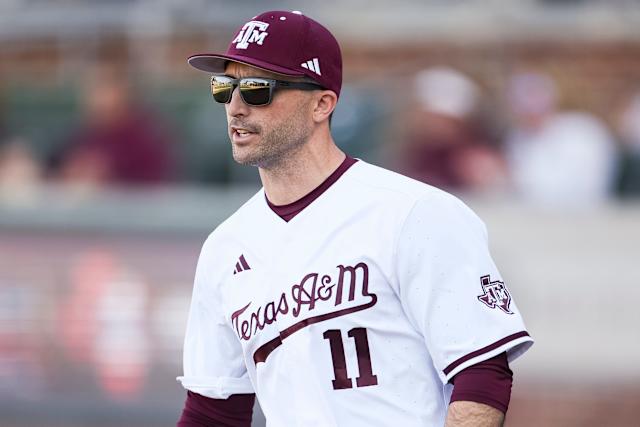The 2024 college baseball season will go down as one of the most shocking collapses in recent memory for Texas A&M. After being crowned the preseason #1 team in the nation and boasting the highest Name, Image, and Likeness (NIL) payroll in college baseball, the Aggies failed to even qualify for the NCAA Tournament—a stunning fall from grace that has left fans, analysts, and the college baseball world in disbelief.
When the season began, Texas A&M was the unanimous favorite to not only reach the College World Series but to win it. The Aggies returned a loaded roster, headlined by star players who had been retained or recruited thanks to one of the most robust NIL collectives in the sport. With elite pitching, a deep lineup, and a coaching staff led by Jim Schlossnagle—who had previously taken TCU to multiple CWS appearances—everything pointed toward a historic season in College Station.
Yet, as the season unfolded, cracks began to show. The Aggies started strong, as expected, but midseason struggles exposed critical flaws. Injuries played a part, but more concerning was the team’s inability to perform in clutch moments. Key series losses to SEC rivals like Arkansas, LSU, and Tennessee revealed a team that, despite its talent, lacked the consistency and mental toughness required to compete at the highest level.
The most damning indictment of Texas A&M’s season was its performance in the SEC Tournament. Needing a strong showing to solidify an at-large bid, the Aggies instead floundered, losing early and looking outmatched in critical situations. When the NCAA Tournament field was announced, Texas A&M’s name was nowhere to be found—a shocking omission for a program that had been the preseason favorite and a perennial contender in recent years.
So, what went wrong? How did a team with so much promise, financial backing, and elite talent fail to even make the postseason?
1. Over-Reliance on Talent Without Chemistry
One of the biggest criticisms of this year’s Texas A&M team was that it lacked the cohesion of past squads. While NIL money helped assemble a roster filled with high-profile transfers and recruits, the team never fully gelled. Baseball is a sport where chemistry and timing matter just as much as raw talent, and the Aggies often looked like a collection of individuals rather than a unified team. Clutch hitting was inconsistent, defensive miscues were costly, and the pitching staff—while talented—struggled to find rhythm in high-pressure moments.
2. Failure to Adapt in the SEC Gauntlet
The SEC is the toughest conference in college baseball, and this year was no exception. Teams like Tennessee, Kentucky, and Arkansas were relentless, and the Aggies were unable to keep pace. While they had the talent to compete, their inability to make in-game adjustments—whether at the plate or on the mound—proved fatal. Schlossnagle, known for his strategic acumen, seemed unable to find the right lineup combinations or bullpen management to close out tight games.
3. The Pressure of Expectations
Being preseason #1 comes with immense pressure. Every opponent circles Texas A&M on the schedule, and the Aggies became the team everyone wanted to beat. Instead of thriving under the spotlight, they wilted. Key players who were expected to carry the team—particularly some of the high-profile NIL beneficiaries—struggled in big moments. The weight of expectations seemed to suffocate the squad as the season progressed, leading to uncharacteristic mistakes and a lack of confidence in must-win games.
4. NIL: A Double-Edged Sword
There’s no question that NIL has changed college sports, and Texas A&M’s baseball program has been at the forefront of leveraging it to build a superteam. However, this season raised questions about whether massive NIL investments can sometimes backfire. When players are compensated at a high level before even stepping on the field, the hunger to prove themselves can diminish. While this isn’t universally true—many NIL-backed athletes still play with a chip on their shoulder—it’s possible that the financial security of some players led to complacency.
Additionally, the Aggies’ NIL dominance created a target on their backs. Opposing teams used the “bought, not built” narrative as motivation, and the pressure to justify the payroll became a storyline all season. When the losses piled up, the scrutiny only intensified.
5. Coaching Questions Loom
Jim Schlossnagle is one of the most respected coaches in college baseball, but this season will undoubtedly raise questions about his ability to manage a roster with this much hype. Did he struggle to balance egos in the locker room? Were his in-game decisions as sharp as in past years? While it’s too early to call for any drastic changes, the fact remains that a team with this much talent should never miss the tournament entirely. Schlossnagle will need to reevaluate his approach heading into next season.
What’s Next for Texas A&M?
The Aggies now face an offseason of soul-searching. The program has too much infrastructure, financial support, and recruiting pull to stay down for long, but this season was a humbling reminder that money and preseason rankings don’t guarantee success.
The transfer portal will be active, and Texas A&M will likely reload with more high-profile names. But the focus should shift from simply acquiring talent to building a team that can handle adversity. Leadership within the locker room must improve, and Schlossnagle will need to re-establish the culture that made him so successful at TCU.
For the fans, this season will sting. Missing the tournament entirely after starting at #1 is an embarrassment, and rivals will not let them forget it. But if there’s a silver lining, it’s that the Aggies now have a clear understanding of what not to do. The 2025 season will be about redemption—and proving that this year was an aberration, not the beginning of a trend.
In the end, Texas A&M’s 2024 season serves as a cautionary tale for the modern era of college athletics. Talent and money are important, but they mean nothing without heart, chemistry, and execution. The Aggies learned that lesson the hard way. Now, it’s up to them to respond.



